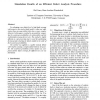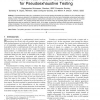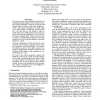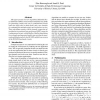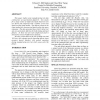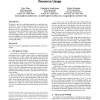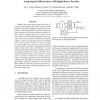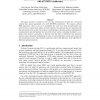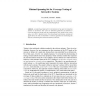ITC
1994
IEEE
15 years 4 months ago
1994
IEEE
For obtaining a zero defect level, a high fault coverage with respect to the stuck-at fault model is often not sufficient as there are many defects that show a more complex behavi...
104
Voted
ITC
1993
IEEE
15 years 4 months ago
1993
IEEE
ÐPseudoexhaustive testing of a combinational circuit involves applying all possible input patterns to all its individual output cones. The testing ensures detection of all detecta...
112
click to vote
SIGSOFT
1998
ACM
15 years 4 months ago
1998
ACM
This paper reports on an empirical evaluation of the fault-detecting ability of two white-box software testing techniques: decision coverage (branch testing) and the all-uses data...
93
Voted
ICCAD
1998
IEEE
15 years 4 months ago
1998
IEEE
This paper presents two new algorithms, Redundant Vector Elimination(RVE) and Essential Fault Reduction (EFR), for generating compact test sets for combinational circuits under th...
81
Voted
ITC
2000
IEEE
15 years 5 months ago
2000
IEEE
This paper studies some manufacturing test data collected for an experimental digital IC. Test results for a large variety of single-stuck fault based test sets are shown and comp...
100
Voted
GLVLSI
2002
IEEE
15 years 5 months ago
2002
IEEE
We present a novel test scheduling algorithm for embedded corebased SoC’s. Given a system integrated with a set of cores and a set of test resources, we select a test for each c...
106
Voted
VTS
2003
IEEE
15 years 6 months ago
2003
IEEE
Irreversible computation necessarily results in energy dissipation due to information loss. While small in comparison to the power consumption of today’s VLSI circuits, if curre...
106
Voted
ITC
2003
IEEE
15 years 6 months ago
2003
IEEE
Multiple-detect test sets have been shown to be effective in lowering defect level. Other researchers have noted that observing the effects of a defect can be controlled by sensit...
96
Voted
DFT
2003
IEEE
15 years 6 months ago
2003
IEEE
1 This paper presents a solution to the test time minimization problem for core-based systems that contain sequential cores with STUMPS architecture. We assume a hybrid BIST approa...
104
Voted
ICTAC
2004
Springer
15 years 6 months ago
2004
Springer
A model-based approach for minimization of test sets for interactive systems is introduced. Test cases are efficiently generated and selected to cover the behavioral model and the ...
